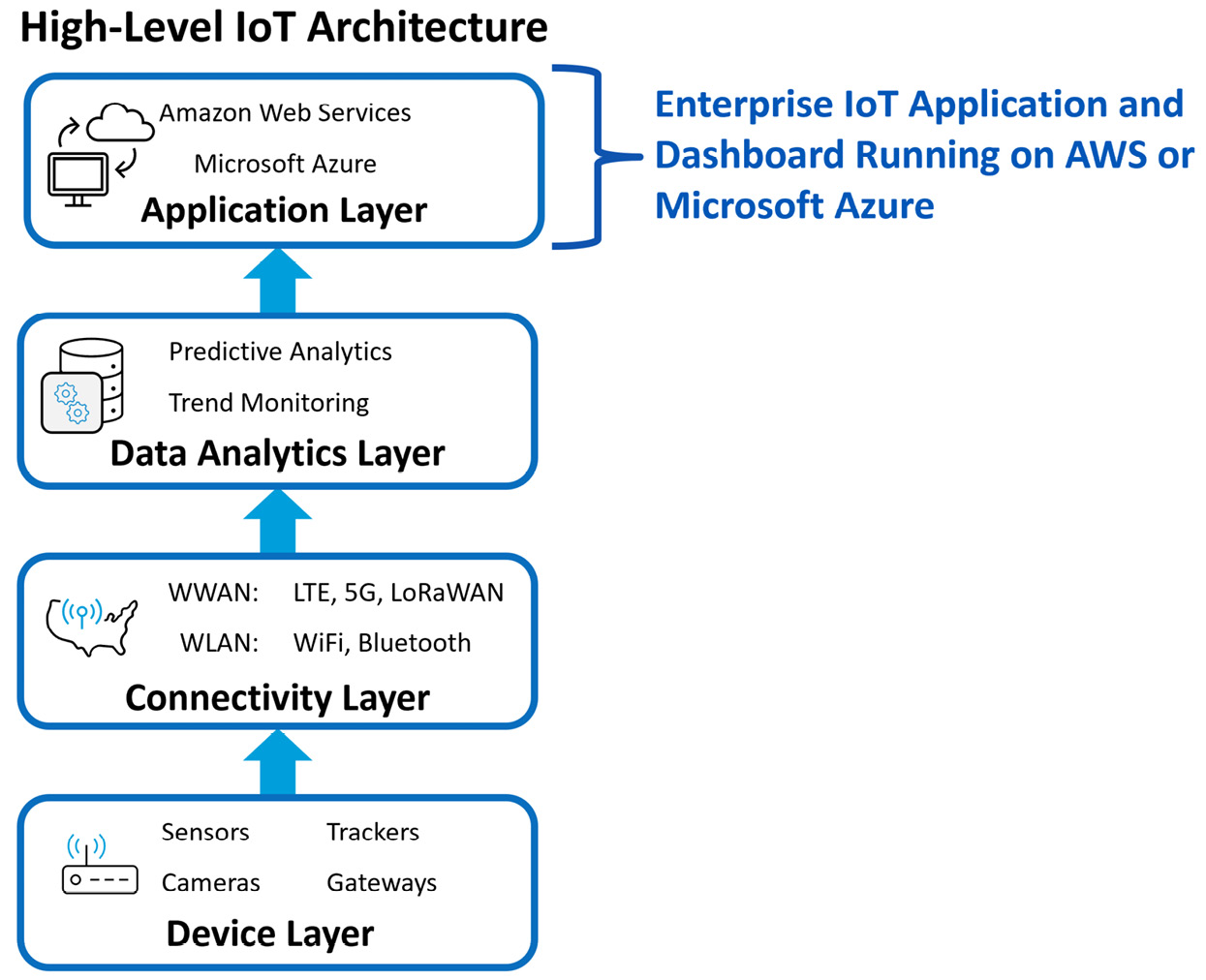In this section, you will learn about the underlying IoT technologies while using a high-level IoT solution end-to-end architecture as a guide. This includes IoT devices, connectivity, data analytics, and applications. The goal of this section is to provide you with a practical understanding of an IoT solution that will form the basis for an enterprise’s digital transformation, as discussed in the next section.
At a high level, an IoT solution consists of four basic layers, as shown in the following figure:
Figure 1.1 – High-level IoT architecture
The device layer is the actual physical device or thing in IoT that is connected to the internet. It captures critical IoT sensor data such as temperature, humidity, light, and air quality for remote monitoring applications. We will explore IoT devices in more detail in Chapter 6, Reviewing Cellular IoT Devices with Use Cases, but some common IoT devices that gather this sensor data include gateways, routers, and asset trackers. This sensor data can include location data for assets such as cars and enterprise fleets, health data for remote patient monitoring (RPM), or video data for security. We will cover IoT device types in more detail in Chapter 2, Understanding IoT Devices and Architectures, and describe how an IoT device is the foundation for an IoT solution. We will also discuss the near real-time processing of data at the device layer, known as edge computing, which is a growing and important trend that is driving tremendous growth in enterprise IoT.
The connectivity layer is the wireless or wired connectivity, which is the gateway to the internet. This could be a wireless local area network (WLAN) technology such as Wi-Fi, Bluetooth, or Zigbee or a wireless wide area network (WWAN) technology such as cellular or LoRaWAN. As we will discuss in Chapter 2, Understanding IoT Devices and Architectures, and Chapter 3, Introducing IoT Wireless Technologies, WLAN technologies rely on a WAN gateway device to backhaul connectivity to the internet. Although several wireless technologies enable IoT, which we will present in Chapter 3, Introducing IoT Wireless Technologies, we will make the case that cellular technologies such as LTE and 5G are unique enablers for the new and transformative IoT business models, which is part of the reason why cellular IoT devices grew 18% year-over-year to reach 2 billion by the end of 2021 (source: IoT Analytics). More specifically, Low Power Wide Area (LPWA) cellular technologies such as LTE Category M (LTE-M) and Narrow Band IoT (NB-IoT) offer unique features in terms of lower cost and power that further enable new IoT applications. In Chapter 3, Introducing IoT Wireless Technologies, we will provide much more detail on both licensed and unlicensed wireless IoT technologies, especially LPWA, and how they enable the growth of enterprise IoT solutions and new IoT business models. In Part 2, we will do a deep dive into cellular IoT wireless technologies.
The data analytics layer is where the IoT device data is processed and is typically implemented in combination with the application layer in the domain of a Cloud Service Provider (CSP) such as Amazon Web Services (AWS) or Microsoft Azure. The data analytics layer is where the value of the IoT device data is realized in terms of data analytics and actionable data for an enterprise IoT solution. As mentioned earlier, for many IoT applications, much of the IoT data processing is moving from the data analytics layer in the cloud to the device, which is known as “edge” data processing. This enables more real-time and low-latency applications such as intelligent transportation (for example, autonomous vehicles), augmented/virtual reality, and video intelligence. We will go into more detail on IoT data processing in the context of IoT architectures in Chapter 2, Understanding IoT Devices and Architectures.
The application layer is the dashboard for the IoT solution that pulls together the IoT device data with the connectivity and processing into a meaningful presentation. For example, in the case of asset tracking, this would be a map showing the location and contiguous path of an asset such as a fleet vehicle or container, along with temperature and humidity sensing data/alerts along the way. Behind the application is where data processing takes place. This involves the time series data from the IoT device along with sensor and location data. In this example, the asset tracking application in combination with the underlying data processing provides not only a better user experience in monitoring the asset but also identifies patterns that drive business decisions around real operational cost savings. We will cover the IoT application protocols, including MQTT and CoAP, in more detail in Chapter 2, Understanding IoT Devices and Architectures.
We will review the end-to-end IoT solution architecture in more detail in Chapter 2, Understanding IoT Devices and Architectures, but at a high level, these four IoT layers are the basis for an enterprise IoT digital transformation in terms of improved customer experience, real-time insights leading to operational cost savings, and new service business lines. In the Understanding IoT markets section, we will discuss the top IoT markets, along with some example applications in each market, that helped create a digital transformation strategy that is being adopted by more and more businesses. While in 2018, 57% of businesses adopted IoT in some way, this increased to 94% in 2021 (source: Aruba Research Report, Microsoft). Moreover, 83% of organizations that employed IoT technology have reported a significant increase in business efficiency (source: Aruba Research Report, Microsoft). In the next section, we will learn how IoT can drive enterprise digital transformation.



 Free Chapter
Free Chapter

